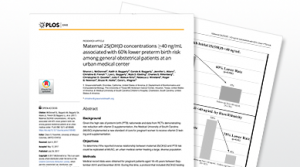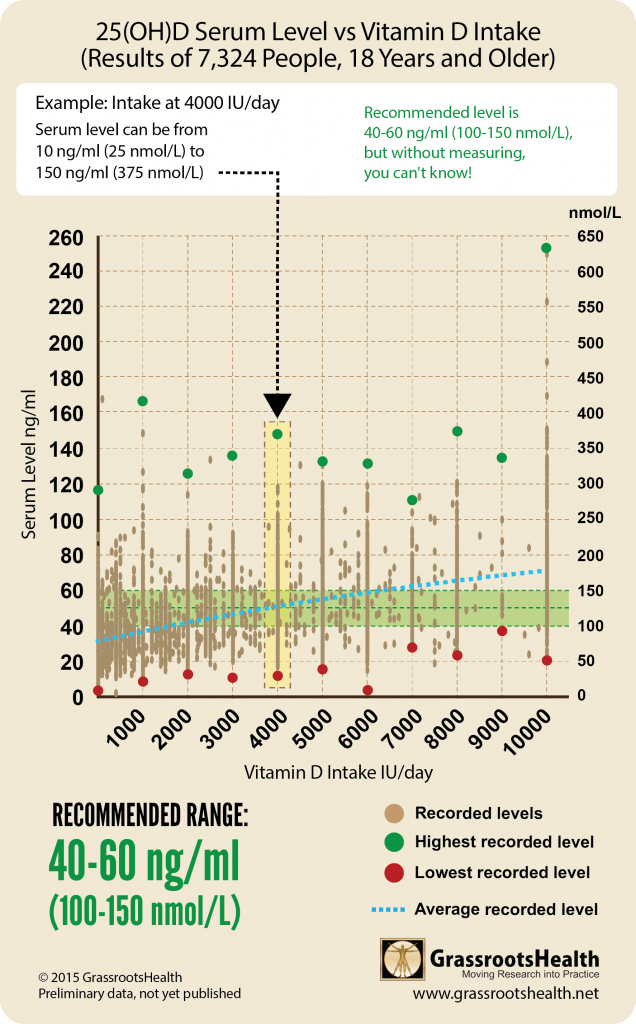Published on January 13, 2021
Insight on how GrassrootsHealth collects data, why we collect the data we do, how it is used to help you with your health decisions and to move research into practice
Becoming a participant of GrassrootsHealth means that you are joining thousands of people in collaborating with us on nutrient research – we call it “citizen science.” Citizen science welcomes everyone’s participation in the discovery and sharing of scientific knowledge. As a citizen scientist, you’ll help us gain a better understanding of the role of nutrients in health and disease, and use the results to help inform public health officials to create change. Additionally, you can use your results to make informed decisions about nutrients that affect your health.
Why the long questionnaire?
 GrassrootsHealth could provide testing without asking you to fill out a questionnaire, but without that data we would have no way of measuring an effect. It would be a public service, especially back in 2009 when we started and it was hard to get a doctor to order a vitamin D test. But we founded GrassrootsHealth for more than testing. We founded GrassrootsHealth based on science, by first gathering together over 40 vitamin D researchers to form a panel of experts, then having those researchers come to a consensus on what the optimal vitamin D blood levels should be for general good health. The consensus they reached was for vitamin D levels to be in the range of 40-60 ng/ml (100-150 nmol/L). By asking about health, nutrient supplementation, and other exposures we can connect each participant’s blood levels with their lifestyle and health status and help guide scientific answers to personal questions.
GrassrootsHealth could provide testing without asking you to fill out a questionnaire, but without that data we would have no way of measuring an effect. It would be a public service, especially back in 2009 when we started and it was hard to get a doctor to order a vitamin D test. But we founded GrassrootsHealth for more than testing. We founded GrassrootsHealth based on science, by first gathering together over 40 vitamin D researchers to form a panel of experts, then having those researchers come to a consensus on what the optimal vitamin D blood levels should be for general good health. The consensus they reached was for vitamin D levels to be in the range of 40-60 ng/ml (100-150 nmol/L). By asking about health, nutrient supplementation, and other exposures we can connect each participant’s blood levels with their lifestyle and health status and help guide scientific answers to personal questions.
By asking about demographic and lifestyle information, health history and current conditions, we track how vitamin D blood levels, and your other results, are associated with disease. We want to determine if an association between these results and a particular health condition exists, and if it does, how strong the association is or how it may change based on vitamin D status and that of the other results provided.
By asking questions about your level of pain, frequency of colds, supplement intake, and other measurements, we are able to provide you with important statistics and graphs to provide greater insights on your health and how it compares with that of 1000’s of other people, allowing you to make more informed decisions about your health.
In short, your data matters!
What happens to the data that is recorded through the questionnaire?
 All data is held in a secure database. It is only shared in a de-identified form (no names) with other qualified researchers.
All data is held in a secure database. It is only shared in a de-identified form (no names) with other qualified researchers.
Our customer service staff uses the contact information to send notifications about test results and when it is time for the next test.
One staff member on our research team reviews questionnaire responses and test results to try and spot things out of the ordinary that may need clarification or correction. If there is a newly reported disease, they may contact that participant to request medical records.
All other research team members see only the questionnaire and test result data – they do not have access to the personal identification information. They conduct data analysis using the de-identified data and put together summary data reports and graphs. We have published newsletters and created educational materials around this data such as how vitamin D relates to sex, age, or latitude (Your Data, Your Answers). GrassrootsHealth has also published many peer-reviewed research papers.
Top 3 Areas of Interest
We could ask many more questions than we do on our questionnaire. It is great to have lots of data to compare with vitamin D and nutrient blood levels, but we understand that there is a limit to how much time people are generally willing to spend filling out a questionnaire.
For vitamin D, most of the known research has been done in populations with low blood concentrations of 25(OH)D, with very low supplementation (< 2,000 IU/day), or with bulk supplementation, large doses given once a month. Our data set is unique in that many of our participants take over 4,000 IU/day and our average serum level is 44 ng/ml (110 nmol/L).
Area of Interest #1 – Dose Response
Is it really true that one person can supplement with 1000 IU/day and have a vitamin D level of 50 ng/ml, while another takes 10,000 IU/day and only has 40 ng/ml? What can we surmise by reported supplementation and sun exposure versus the measured vitamin D level?
Above is a version of one of the first graphs we published. It is a dose-response curve using data from 7324 participants that shows the average dose response (how much the vitamin D level goes up with increased supplementation), as well as the wide variation of vitamin D levels at each level of intake. The curve also shows that the response is not linear – it is steeper at lower levels and then flattens out at higher levels. The vitamin D dose-response can be affected by intake of other nutrients, such as magnesium and vitamin K2 – another reason we ask about supplement intake in such detail. The same wide variation in individual response has also been shown with omega-3 supplementation and resulting Omega-3 Index levels — the individual response varies, which is why it is so important to test!
We also used our vitamin D dose-response data – your data – to respond to the IOM regarding the current RDA. We helped publish a paper that used a statistical analysis to show how much supplementation it would take to get 97.5% of the population above 20 ng/ml. Based on GrassrootsHealth data — YOUR data, it would take approximately 7,000 IU/day for 97.5% of the population to achieve 20 ng/ml.
Area of Interest # 2 – Disease analysis
We have researchers on our panel of scientists who specialize in specific diseases or conditions, such as diabetes, cancer, or pregnancy. Our data can help them research relationships with vitamin D and the other values measured using diagnosis date, levels before diagnosis, and levels after diagnosis. Our dataset also includes other factors that might be important, such as gender, age, smoking status, exercise, latitude, weight, BMI, and occupation.
Overall we can explore which health conditions are associated with which measured levels of vitamin D status. We can also drill down by disease and find what serum level range(s) are indicated for the prevention of that disease. From there we can compute how much disease could be prevented with target serum levels, such as vitamin D in the range of 40-60 ng/ml (100-150 nmol/L).
Area of Interest #3 – Fluctuations of D-levels over time
 Our database has also shown that many of our participants’ D-levels change throughout the year. By looking at the other data included in the questionnaire, we can try and correlate the vitamin D level change to other factors – including sun exposure, UV light, or other supplements.
Our database has also shown that many of our participants’ D-levels change throughout the year. By looking at the other data included in the questionnaire, we can try and correlate the vitamin D level change to other factors – including sun exposure, UV light, or other supplements.
When information from the questionnaire cannot explain observed differences, we may contact the participant to try to gather more information. For example, we know that a recent illness or injury can result in lower than usual levels, however sometimes we see that it is higher, sometimes much higher. With our additional questioning, we have learned that some people will take an extra large dose for a few days if they feel a cold coming on, others have reported taking extra after an injury such as a sprained ankle. These extra large doses can result in a temporary spike in D levels.
We have also learned from several anecdotes that foods and supplements that may not contain any vitamin D can have an impact on how we absorb the D we get from other foods/supplements.
Why doesn’t my doctor ask for this data when I get a test through my doctor (a lab)?
Your doctor already has a lot of the information – they have your current health history; they do generally ask if you have been smoking or drinking alcohol; they do take your height, weight, and blood pressure measurements.
The questions that differ are specifically related to the nutrient research at GrassrootsHealth – to gauge skin exposure we ask how much time is spent outdoors, clothing worn when outdoors, sunscreen usage, and use of indoor UV equipment; for nutrient intake we also ask about brand and type of specific supplements used in addition to the total amount.
What good has my data done for vitamin D research?
 Most vitamin D research has been done with low supplement levels and low serum levels. The GrassrootsHealth cohort is providing information on what happens at higher levels. A major outcome to date includes the safety as well as the benefits of having vitamin D levels in the 40-60 ng/ml (100-150 nmol/L) range.
Most vitamin D research has been done with low supplement levels and low serum levels. The GrassrootsHealth cohort is providing information on what happens at higher levels. A major outcome to date includes the safety as well as the benefits of having vitamin D levels in the 40-60 ng/ml (100-150 nmol/L) range.
Please see our website for some of the papers and charts that have been published from the D*action data, our “Resources” tab for more, and our Moving Research into Practice booklet for an easy-to-read summary. One of the first key findings was our dose-response curve mentioned earlier. Another paper challenged the belief that high intake of vitamin D, and higher serum levels, were associated with increased rates of kidney stones. Other GrassrootsHealth publications have focused on the relationship of vitamin D levels with cancer, preterm birth, and type 2 diabetes.
Our Deepest Appreciation to Our Participants!
Thank you! The data you have provided through D*action is doing, and has already done, much to move science into practice. We know the questionnaire can be long, but look at all the good it is doing for you as well as others. It is exciting that we have such a large group of people who are willing to provide information and test.
Beyond simply testing to find out your vitamin D level, we hope by reading this that you now know how the information you provide with each questionnaire helps others as well. This is a great example of what can be done – one person at a time – with a grassroots effort.
How can I track my vitamin D intake and level?
To help you track your vitamin D levels, GrassrootsHealth has created an online tracking system called myData-myAnswers. This will help you know how your supplementation and intake may be affecting your vitamin d levels and impacting your health. Check it out today!









